Posted by June Underwood on November 23rd, 2007
Probably because I grew up in the careless and tasteless 1950’s, before Lady Bird pointed out that the landscape was filling with garbage, but after logging and poverty had been pretty well trashed my neck of the woods — that is, because I had a visually impoverished childhood — I find living in this city a continuing visual delight.

Even the rain has its moments.
So I thought for as a bit of thanks-giving, I would meander around Portland Oregon, pointing out the sights that I like. Some of these are constant public presences, like the statue of Harvey Scott in Mt. Tabor Park. Scott was a city “father” as well as an anti-suffragist newsman. (I keep scheming of ways to bring his perfidy to the attention of the city mothers).
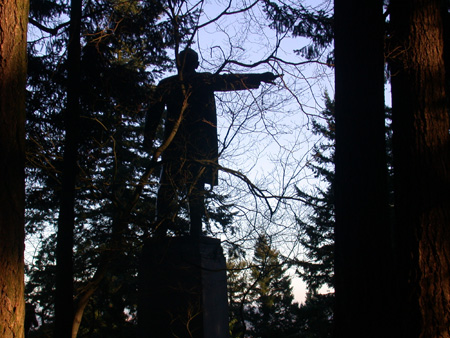
 more… »
more… »
Posted by Sunil Gangadharan on November 21st, 2007
While I had always harbored an unexplained inclination towards abstraction, it is only recently that I have started to explore this form a little more in detail. Part of the exploration involves trying out hitherto untried (at least by me) combination of materials on masonite. Here are two paintings that I attempted recently using a combination of wet gesso, Indian spices and acrylic.

Sunil Gangadharan, ‘Untitled_111007’, Acrylic, Indian spices, latex based housepaint and gesso on dricore, 24″ X 24″
To achieve the dynamic effects and an impasto finish, it was imperative that I work wet on wet – which also meant I could not mull too much on the outcome, just add the colors and the paints as relevant and then stand back and ponder the results…
Pure abstraction is somewhat akin to nature, random interplays of relevant forces that yield unpredictable patterns, moods and feelings.
At certain points during creation of these paintings, I felt some of these interplays intensely.
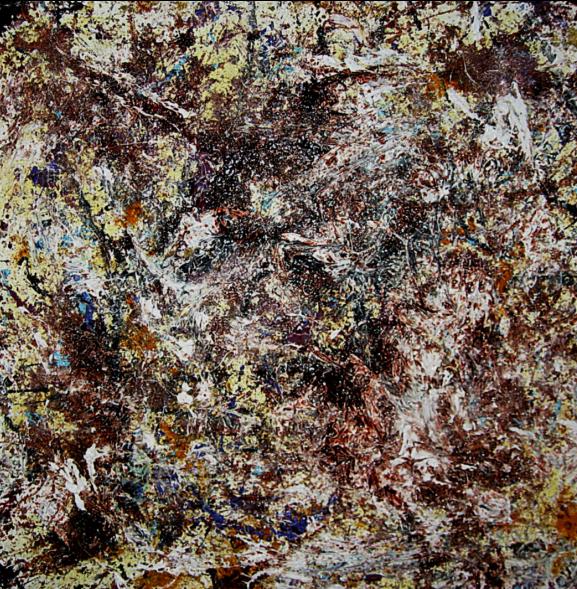
Sunil Gangadharan, ‘Untitled_111707’, Acrylic, Indian spices and gesso on dricore, 24″ X 24″
Posted by Angela Ferreira on November 12th, 2007
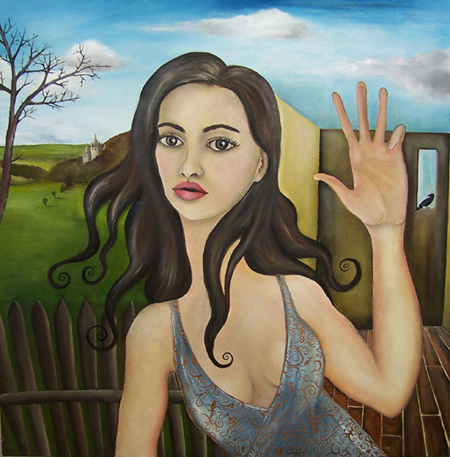
Virginalis sancta frequentia
Hinc virginalis sancta frequentia,
Gertrudis, Agnes, Prisca, Cecilia,
Lucia, Petronilla, Tecla,
Agatha, Barbara, Juliana,
Multeque quarum nomina non lego.
aut lecta nunc his addere negligo,
dignas Deo quas fecit esse
integritas anime fidesque.
Tali magistra vel duce praevia
abominantes terrea gaudia,
in carne praeter carnis usum
angelicam tenuere vitam.
He pervagantes prata recentia
pro velle querunt serta decentia,
rosas legentes passionis
lilia vel violas amoris.
Posted by Jay on November 11th, 2007
Over the course of the last year I have made a number of cut wood letters. I have done so in order to gain process experience and to find the right combination of typefaces, dimensions and treatments in search of a decent question and answer linkage.
Watch a presidential debate and see the tangled relationships between the moderator’s questions and the varied kinds of responses. Messy and devious as it may become at times, the question and answer relationship is a fundamental aspect of the intellectual process. As such it calls out for plastic representation.
The final solution will likely be a tangled mass of big block letters. In the meanwhile I’ll settle for an equally tangled mass of this last year’s experiments.
These are three photos of one piece.
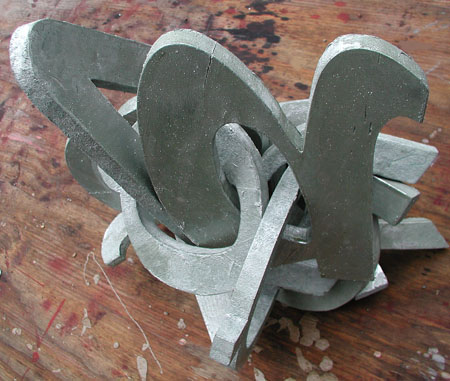
I’m still looking for the right colors. Early on I was giving each letter its own hues and patterns. This raised the visual density, but detracted from any clarity of intention. When undecided, I usually fall back to aluminum paint.
more… »
Posted by June Underwood on November 9th, 2007
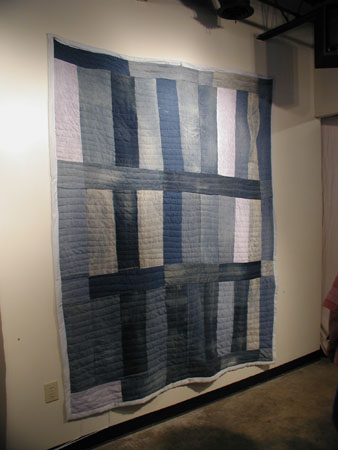
I’ve been following, if not commenting on, the discussions on blogs and their usefulness to a community of artists. And that led me to thinking about communities of artists.
All kinds of communities of artists have existed — ateliers of the Renaissance, –the academies of art — museum schools where students sat on the floor drawing ancient scuptures– the artists who rebelled against the academy in Paris– the Group of Seven took on Emily Carr in the late 1920’s — the New York School whose members drank together at bars, married, divorced, remarried each other– well you get the idea — art camps, colonies, ateliers, workshops, studio spaces, hanging with artists — all comprise community. And now we have the internet, adding another element to the possibility of community.
One of the most fascinating communities of artists is that of the black women of Gee’s Bend, Alabama, whose quilted art was exhibited in Houston and then at the Whitney in 2002. [Michael] Kimmelman in the New York Times November 29, 2002 regarded the exhibit as
“..Some of the most miraculous works of modern art America has produced. Imagine Matisse and Klee (if you think I’m wildly exaggerating, see the show) arising not from rarefied Europe, but from the caramel soil of the rural South in the form of women, descendants of slaves when Gee’s Bend was a plantation. These women, closely bound by family and custom (many Benders bear the slaveowner’s name, Pettway), spent their precious spare time — while not rearing children, chopping wood, hauling water and plowing fields — splicing scraps of old cloth to make robust objects of amazingly refined, eccentric abstract designs. The best of these designs, unusually minimalist and spare, are so eye-poppingly gorgeous that it’s hard to know how to begin to account for them. But then, good art can never be fully accounted for, just described.” (as quoted on the website of Shelly Zegart) more… »
Posted by Sunil Gangadharan on November 8th, 2007

Jeffrey Isaac, ‘George W. Bush leading the war of terror’, 2007, oil on canvas, 250 x 360 cm.
I have been following Jeffrey Isaac‘s paintings for some time now (about a year actually) and a little while back (in an effort to understand some of his works), I had an e-mail conversation on motivations behind his art, his style of oil painting, his choice of subjects and his views on art. The conversations led to the following dialogue (you may call it an interview), presented here.
Some of this is stoked by a particular interest I have had in hearing social commentary from US artists who live outside the States and Jeffrey is an example of such an artist. Sometimes the commentaries developed are richer due to a melding of cultures and as a result their art tends to reflect inherent local perceptions to global social issues. more… »
Posted by Jay on November 7th, 2007
Birgit has asked to see the original. here it is.
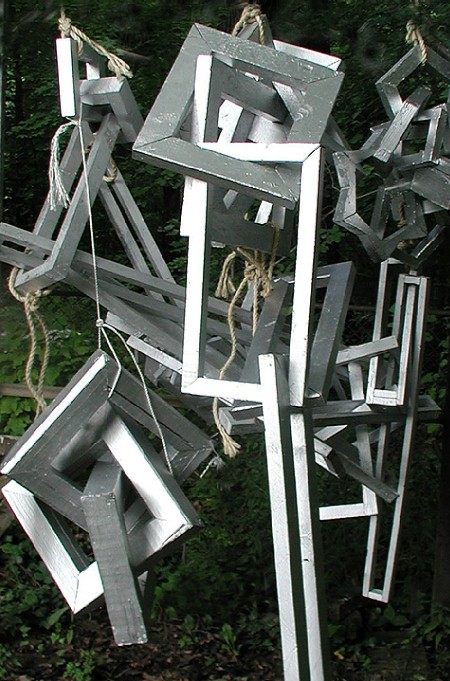
As pointed out elsewhere, this is a bunch of stuff hung up and in a sort of storage. The image in Cubey Do The First dispenses with the foliage.






